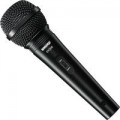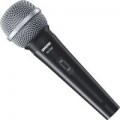Types of connectors provided in the design of the microphone.
Most often, in this paragraph we are talking about the type of connector designed to connect the microphone itself to external audio equipment. Of these interfaces, the most popular nowadays are analogue
XLR(including a smaller version of
mini-XLR),
Jack 6.35 and
mini-Jack 3.5 mm, as well as digital
USB A,
USB-C and
Lightning. Also, individual microphones provide
their own headphone jack(sometimes
Microdot). Here is a more detailed description of each option:
— XLR. A characteristic round plug of a rather large size, usually with an external casing. In microphones, 3-pin XLR plugs are most common, one such plug allows you to transmit one channel of sound; other options are possible — for example, a 4- or even 5-pin connector in a model that supports stereo recording (see "Functions and Capabilities"). Anyway, the main advantage of XLR is the ability to work with a balanced connection. With this connection, most of the interference induced on the cable is extinguished "by itself", without the need for additional filters; this allows fairly long wires to be used without sacrificing sound quali
...ty. In addition, the XLR connectors provide a tight connection, further improving noise immunity; and for additional security, sockets and plugs of this type are often equipped with locks. The main disadvantage of XLR is its large size; therefore, the main scope of its application remains professional models, where the mentioned advantages far outweigh the disadvantages.
— mini-XLR. A smaller version of the XLR interface described above; has the same technical features and differs only in smaller sizes. The latter makes the mini-XLR more suitable for applications where compactness is important. At the same time, such connectors do not yet have official standardization, and therefore are quite rare.
— mini-Jack 3.5 mm. One of the most popular modern audio connectors. In microphones, however, it is much less common than the same XLR — mainly in compact models, as well as entry-level and inexpensive mid-range solutions. This is due to the fact that the mini-Jack is small in size, but noticeably inferior to XLR in terms of quality and connection reliability, which is why it is poorly suited for professional tasks. It is also worth considering that in modern microphones you can find different versions of the 3.5 mm jack:
- mini-Jack 3.5mm TS. A two-pin connector that allows you to transmit only 1 channel of sound (mono). It is found in fairly advanced microphones, and 3.5 mm jacks of this format are used in basic audio equipment of the appropriate level and specialized devices (like transmitters for lavalier microphones).
- mini-Jack 3.5 mm TRS. Three-pin, the most common type of mini-jack connector. Technically, it can be used for balanced connection of one audio channel (see “XLR” above), but in fact it is more often used either for compatibility reasons (so that the microphone can work normally with three- and four-pin jacks on laptops, phones, etc.), or to transmit a stereo signal (in models with the appropriate functionality — see "Functions and Capabilities").
- mini-Jack 3.5mm TRRS. Four-pin mini-jack plug. It is used mainly in models for smartphones / tablets, camcorders and other equipment — such equipment is often equipped with sockets for exactly 4 connectors, and for optimal compatibility, the same number of contacts is also provided on the microphone. Stereo audio can be transmitted through such an interface, but this capability is not necessarily supported.
Ideally, a microphone with a mini-jack should be connected to a connector that has the same number of pins — otherwise, normal operation is not guaranteed (although exceptions are possible).
— Jack (6.35 mm). Full-size Jack; has almost twice the diameter of the 3.5 mm mini-Jack described above. Poorly suitable for portable equipment, but it provides a fairly tight and reliable connection — although it is somewhat inferior to XLR in this parameter; can also be used for balanced connection (see "XLR"), but in this format it is used relatively rarely. Note that in some microphones, the 6.35 mm interface is provided not as a full-fledged plug, but as an adapter for a 3.5 mm mini-jack installed on the wire. The Jack connector can also have a different number of pins, but in this regard it is not as diverse as the mini-jack: the classic 3 pins (TRS) are the most common, and the 4 pin format (TRRS) is practically never found.
— TA4F. A specialized connector used in audio equipment, and mainly in microphones. Also, this term can mean a connector of a similar design TA3F (with 3 contacts).
The TA4F is fairly small, making it suitable for compact head and lavalier microphones. And thanks to the presence of 4 pins, you can also connect phantom power for condenser microphones through it (however, the use of TA4F is not limited to this type of microphone). Note that this connector is considered professional and is found mainly in the technique of the corresponding level.
— USB. The USB interface is mainly used in computer technology — to connect various peripheral devices. At the same time, among models for PCs and laptops (see "Intended use"), this option is much less common than the mini-Jack 3.5 mm described above, and most microphones with USB are studio ones. This is due to the fact that the signal is transmitted via USB in digital format, which is very convenient when recording to a computer for further processing and mixing (but for voice communication it is more convenient to use a regular microphone input). However, there are other types of microphones with this interface.
— Lightning. A proprietary connector used exclusively in Apple portable devices — iPhone smartphones, iPad tablets and iPod touch players. Accordingly, this connection option is found exclusively in microphones for Apple smartphones, moreover, specially designed for this technique.
— microdot. Balanced jack for coaxial connection to musical instruments and other acoustic/audio equipment. The microDot connector is characterized by the presence of a thread, which ensures a high reliability of the connection. The microDot connection is commonly found in compact microphones mounted on a musical instrument.
— Corporate outlet. This category includes all interfaces not related to those described above. These can be not only their own connectors used by a certain company, but also some standard connection types that are not widely used and are found in specialized technology. However, anyway, when buying such a microphone, you should separately make sure that it is compatible with the device with which you plan to use it.
— Headphone output. Separate headphone output. Most often it looks like a standard mini-Jack 3.5 mm jack — it is this interface that is used in most modern "ears", which gives the user a wide choice. In addition, such an output can be combined with its own volume control.
The remaining features of both the connector itself and its application depend mainly on the type of microphone (see "Microphone"). So, lavalier models, when headphones are connected, turn into headsets; when used in karaoke, headphones make it possible to listen to music better, and when used in a studio, they also allow you to hear your own voice, controlling what is being recorded. Also note that in radio systems (see above), such an output is usually located on the receiver.
